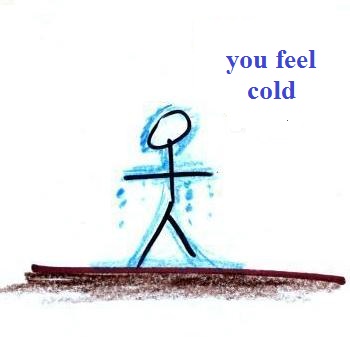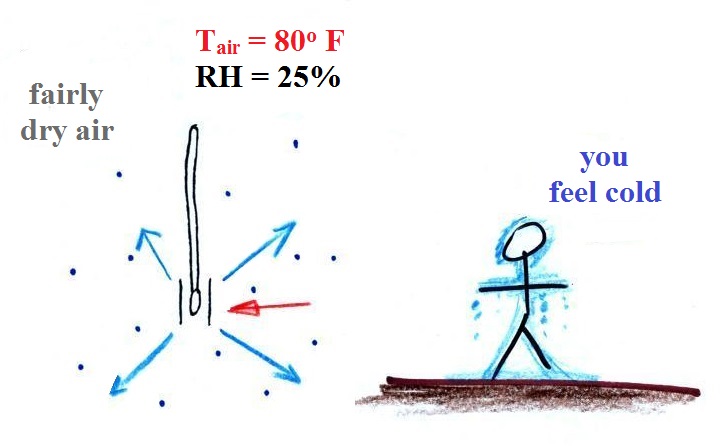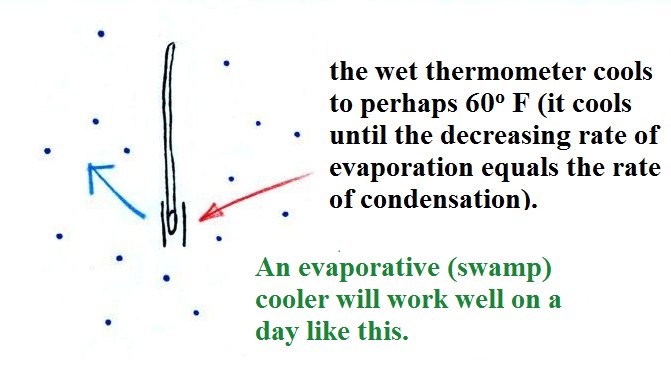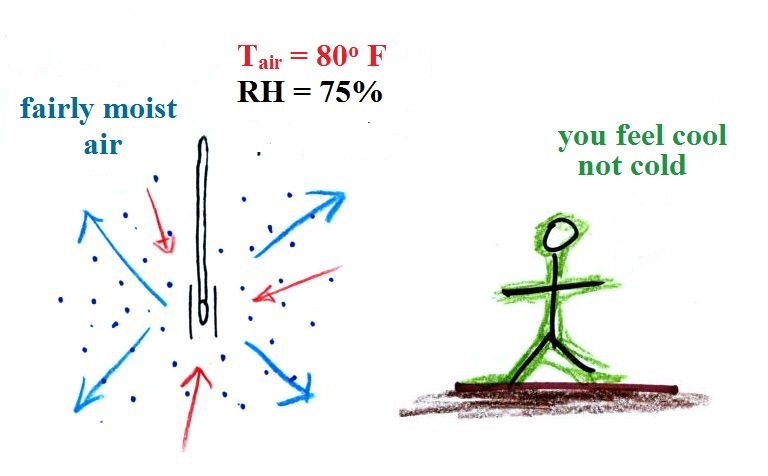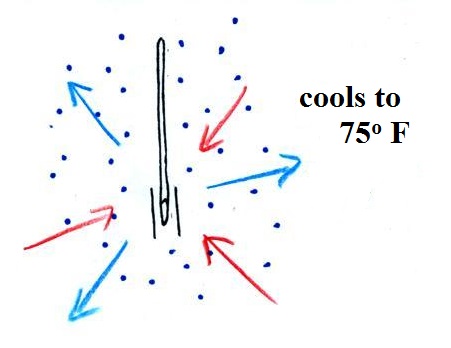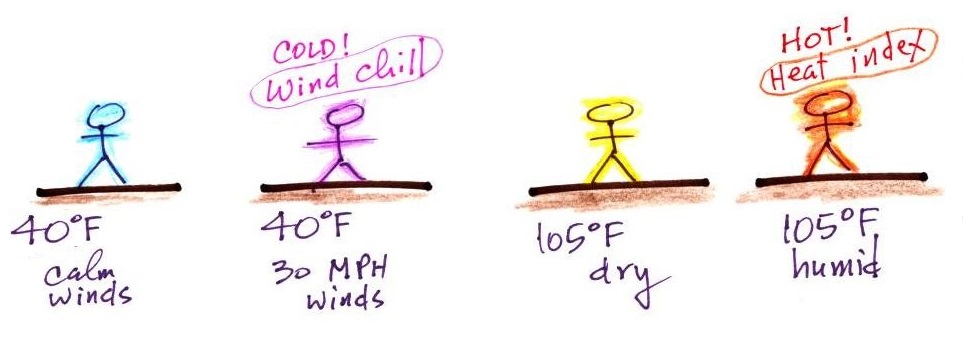One way of measuring humidity - a
sling (swing) psychrometer
A short discussion of how you might try to measure humidity (short
because it's a topic that tends to put people to sleep). One
of the ways is to use a sling (swing is more descriptive)
psychrometer.
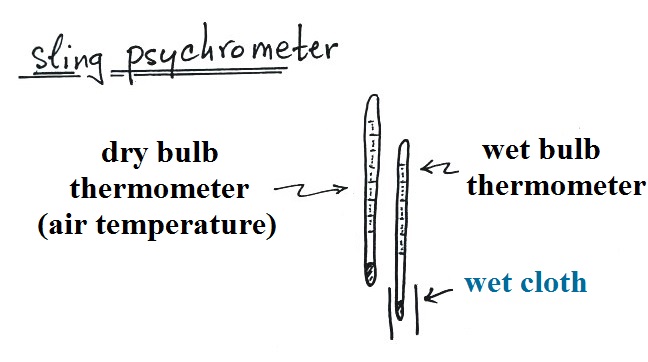
A sling
psychrometer consists of two thermometers
mounted side by side. One is an ordinary
thermometer, the other is covered with a wet
piece of cloth. To make a humidity
measurement you swing the psychrometer around
for a minute or two and then read the
temperatures from the two thermometers.
The dry thermometer measures the air
temperature.
Would the wet thermometer be warmer or colder or
the same as the dry thermometer? You
can check it out for yourself - go get one of
your hands wet. Does it feel the same as
the dry hand? You might blow on both hands
to increase the evaporation from the wet
hand. I think you'll find the wet hand
feels colder. That's basically what
happens with the wet bulb thermometer.
|
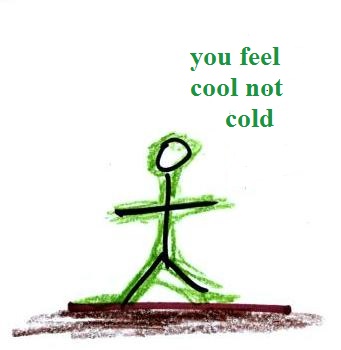
|
What could you say about the relative humidity in
these two situations (you can assume the air
temperature is the same in both pictures).
You would feel coldest on a dry day (the left
picture indicates dry air). The evaporative coolers
that people like me use in Tucson in the summer work much
better (more cooling) early in the summer when the air is
dry. Once the thunderstorm season begins in July and
the air is more humid it is hard to cool your house below 80
F (but by then you're used to it and it doesn't matter too
much).
You feel colder because energy is needed in order for water
to evaporate. The energy in the cases above come from
your body. When your body starts to lose energy you
feel cold.
Here are a bunch of details that
you can read through if you're so inclined. My goal is
that you understand the basic principle behind a sling
psychrometer. If you'd rather not worry about the details
skip to the summary a few pictures further on.
You need to be aware of a few things to understand
the details that follow:
(1a) evaporation is a cooling process
(1b) warm water evaporates more rapidly than cold water
(think of a steaming glass of hot tea and a glass of iced tea)
(2a) condensation is a warming process
(2b) whenever there is any moisture in the
air there will be some condensation, the rate of condensation
depends on how much water vapor is in the air
(3) these two phenomena, evaporation and condensation,
operate independently of each other
Here's the situation on a day with low relative
humidity.
The figure shows what
will happen as you start to swing the wet bulb
thermometer. Water will begin to evaporate
from the wet piece of cloth. The amount
or rate of evaporation will depend on the water
temperature Warm water
evaporates at a higher rate than cool water.
The evaporation is shown as blue arrows because this
will cool the thermometer. The water on
the wet thermometer starts out at 80 F and
evaporates fairly rapidly.
The figure at upper left also shows one arrow of
condensation. The amount or
rate of condensation depends on how much water
vapor is in the air surrounding the
thermometer. In this case (low relative
humidity) there isn't much water vapor. The
condensation arrow is orange because the
condensation will release latent heat and warm the
thermometer.
Because there
is more evaporation (4 arrows) than
condensation (1 arrow) the wet bulb
thermometer will drop. As the
thermometer cools the rate of evaporation
will begin to decrease. The
thermometer will continue to cool until the
evaporation has decreased enough that it
balances the condensation.
The
rates of
evaporation
and
condensation
are
equal.
The
temperature
will now
remain
constant.
The
figure below
shows the
situation on a
day with
higher
relative
humidity.
There's
enough
moisture in
the air to
provide 3
arrows of
condensation.
The rate of evaporation stays the same, the rate of
condensation is higher. The rate of evaporation is
still higher than condensation but not by much.
There'll
only be a little cooling before the
evaporation is reduced enough to be in
balance with condensation.
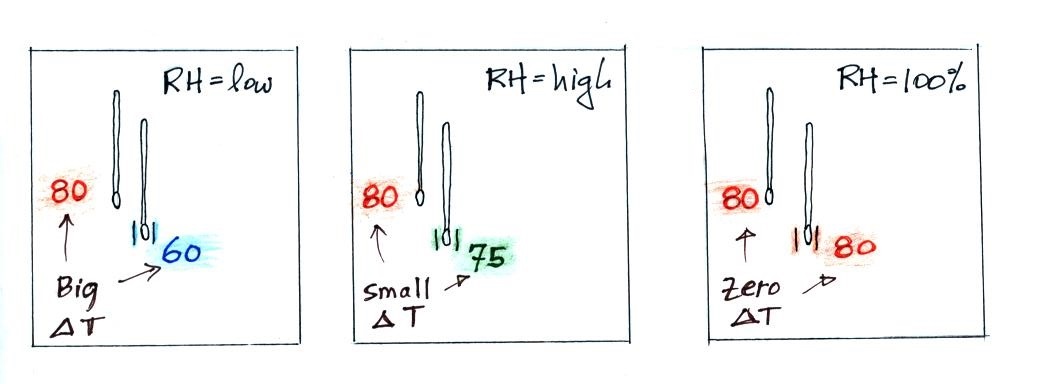
A large difference between the
dry and wet temperatures means the relative humidity
is low. A
small difference means the RH is higher. No
difference means the relative humidity is
100%.
We saw the same kind of relationship between RH and the
difference between air and dew point temperature.
Wind chill and heat index
Cold temperatures and wind make it feel colder than it really
is. The wind
chill temperature tells you how much colder it will feel ( a
thermometer would measure the same temperature on both the calm
and the windy day). If your body isn't able to keep up with
the heat loss, you can get hypothermia
and die.
There's something like that involving heat and
humidity. High temperature and high humidity makes it feel
hotter than it really is. Your body tries to stay cool by
perspiring. You would feel hot on a dry 105 F day.
You'll feel even hotter on a 105 F day with high relative humidity
because your sweat won't evaporate as
quickly. The heat index
measures how much hotter you'd feel. The combination of heat and
high humidity is a serious, potentially deadly, weather hazard
because it can cause heatstroke
(hyperthermia). A thermometer (a dry
thermometer) would measure the same 105 F temperature on both a
dry and a humid day.


